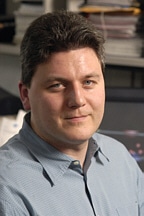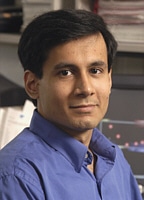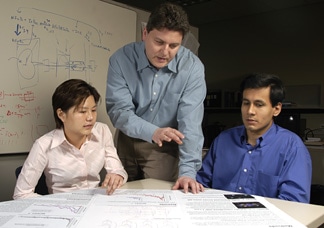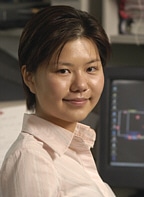Mar 22 2004
Two biomedical engineering students at Johns Hopkins are mapping the interaction of molecules within a cardiac cell, describing microscopic movements that could be critical for maintaining a healthy heartbeat. The students, seniors Bhuvan Srinivasan and Carol Xiaoying Koh, have presented their findings at two prestigious computational biology conferences and are now collaborating with their faculty supervisor on a paper for a scientific journal.
 Within a detailed computer model, the two have been tracking the activity of molecules in a small region inside cardiac myocytes, the muscle cells that mediate contractions of the heart. The students have performed their research in the laboratory of Andre Levchenko (pictured at left), an assistant professor in the Department of Biomedical Engineering. "The contraction of the myocytes is controlled by tiny sub- sections of the cell with a volume so small that you could count some of the molecules present there on one hand," Levchenko said. "But by modeling the interaction between single molecules in these areas, we think we can predict what's going to happen to the entire heart. What happens here sets off a chain reaction of events leading to heart contraction."
Within a detailed computer model, the two have been tracking the activity of molecules in a small region inside cardiac myocytes, the muscle cells that mediate contractions of the heart. The students have performed their research in the laboratory of Andre Levchenko (pictured at left), an assistant professor in the Department of Biomedical Engineering. "The contraction of the myocytes is controlled by tiny sub- sections of the cell with a volume so small that you could count some of the molecules present there on one hand," Levchenko said. "But by modeling the interaction between single molecules in these areas, we think we can predict what's going to happen to the entire heart. What happens here sets off a chain reaction of events leading to heart contraction."
Levchenko is impressed by what Srinivasan and Koh, as undergraduates, accomplished in assembling parts of this model. "The level of work done by Bhuvan and Carol is close to that of very good graduate students," Levchenko said. "I've given them a little advice, but they've mostly run with it by themselves. They're exceptional students. I've sometimes come into the lab at 3 a.m. and found them working on the project."
 Srinivasan (pictured at right), 22, has been working in Levchenko's lab for two years. He used a Provost's Undergraduate Research Award grant from the university to devote additional time to the project last summer. Koh, 21, has been working in the lab for more than a year, supported by a scholarship from the government of Singapore. The two students attended the same high school in Singapore but were not acquainted before they arrived at Johns Hopkins.
Srinivasan (pictured at right), 22, has been working in Levchenko's lab for two years. He used a Provost's Undergraduate Research Award grant from the university to devote additional time to the project last summer. Koh, 21, has been working in the lab for more than a year, supported by a scholarship from the government of Singapore. The two students attended the same high school in Singapore but were not acquainted before they arrived at Johns Hopkins.
Over the past year, they worked on separate aspects of the research, then put their findings together. Koh has defined and spearheaded the project by gathering information from the literature and coding it into the modeling software. Srinivasan assembled a computer model of the protein kinase A pathway, a communication route along which signals move between the outside and inside of the cell. The model can now describe molecular events arising both from signaling and cell contraction regulation. "Now, we can ask, 'What if something happens to this pathway?'" Levchenko said. "How would it affect the interaction of molecules within the cells, and how would this affect the contractions of the heart as a whole?"
 Andre Levchenko, assistant professor of biomedical engineering, supervises students Carol Xiaoying Koh and Bhuvan Srinivasan in their study of the interaction of molecules within cardiac cells.
Andre Levchenko, assistant professor of biomedical engineering, supervises students Carol Xiaoying Koh and Bhuvan Srinivasan in their study of the interaction of molecules within cardiac cells.
ALL PHOTOS BY WILL KIRK |
Last fall, Srinivasan presented some of the team's work at the NIH Digital Biology Conference in Bethesda, where the poster was singled out as a highlight of the meeting. Koh traveled to Washington University in St. Louis to present the research at the International Conference on Systems Biology, the premiere event in the emerging scientific field. Both were surprised to discover that they were the rare undergraduate presenters fielding questions from prominent full-time researchers, including some whose work they had studied. Srinivasan asked a Nobel Prize winner for his autograph. "We felt very honored to be presenting at these conferences," Koh said.
Srinivasan won't receive his bachelor's degree until May, but he already has begun working toward his master's degree in biomedical engineering at Johns Hopkins. "It was definitely a big deal for me to come to America's first research university," said Srinivasan, a citizen of India whose family relocated to Singapore when he was in sixth grade. "It's been very easy to get involved in research here and to do something worthwhile, not just cleaning lab equipment. I liked working with Dr. Levchenko, and I wanted to stay as long as I could."
 Koh (pictured at right) also expects to receive her bachelor's degree in May and hopes to pursue graduate studies in a biomedical engineering program. "When I joined this lab, I didn't have much experience in computational modeling, so I was apprehensive," she said. "But Dr. Levchenko was very encouraging. This was the first serious research project I'd tried, and it became somewhat of an obsession. But it was a healthy obsession."
Koh (pictured at right) also expects to receive her bachelor's degree in May and hopes to pursue graduate studies in a biomedical engineering program. "When I joined this lab, I didn't have much experience in computational modeling, so I was apprehensive," she said. "But Dr. Levchenko was very encouraging. This was the first serious research project I'd tried, and it became somewhat of an obsession. But it was a healthy obsession."
Kenny Ching, a former undergraduate at Levchenko's lab and currently a master's student at MIT, also contributed to the research. On Thursday, March 11, Steven Knapp, university provost and senior vice president for academic affairs, will host the 11th annual Provost's Undergraduate Research Awards ceremony, which will honor the 41 winners who conducted their projects in the summer and fall of 2003. Since 1993, about 40 students each year have received PURA grants of up to $3,000 to conduct original research, some results of which have been published in professional journals. The awards, funded through a donation from the Hodson Trust, are an important part of the university's commitment to research opportunities for undergraduates.
The Johns Hopkins University is recognized as the country's first graduate research university, and has been in recent years the leader among the nation's research universities in winning federal research and development grants. The opportunity to be involved in important research is one of the distinguishing characteristics of an undergraduate education at Johns Hopkins.
The Provost's Undergraduate Research Awards program provides one of these research opportunities, open to students in each of the university's four schools with full-time undergraduates: the Krieger School of Arts and Sciences, the Whiting School of Engineering, the Peabody Conservatory and the School of Nursing.